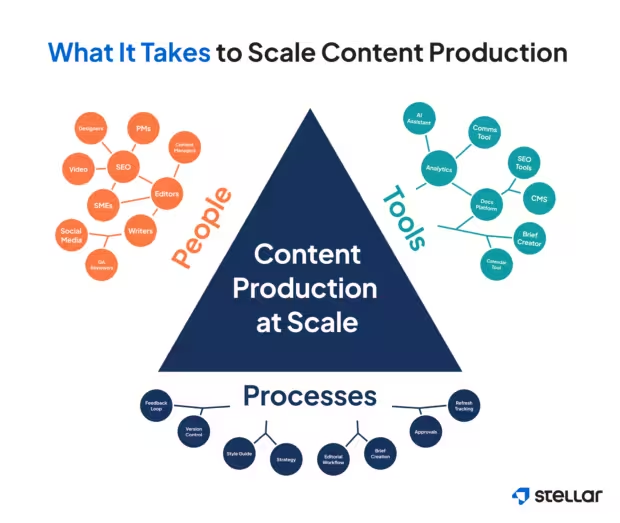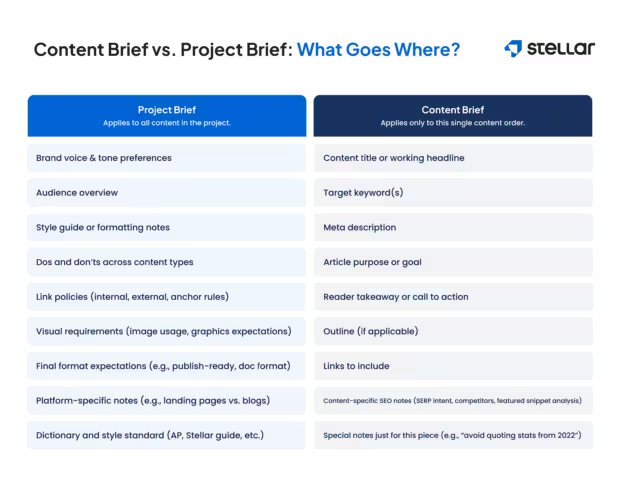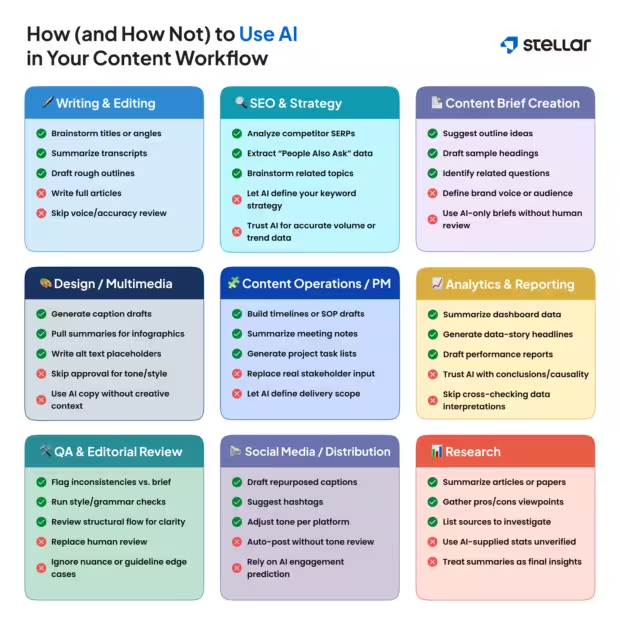
Creating a single piece of well-written, effective content isn’t an easy task, but dozens? Hundreds? It’s an enormous project that requires a solid strategy for scaling.
When done correctly, scaling your content creation can:
- Increase your visibility and audience engagement
- Solidify your authority in your industry
- Create opportunities for more conversions
Scaling can’t be done by just hiring a couple of writers and editors and pointing them at a content calendar.
To scale your content, you’ll need to:
- Define your goals and strategy
- Assess current processes, tools and people
- Create optimized processes and workflows
- Create a comprehensive content calendar
- Create a project brief
- Create content briefs
- Invest in quality control
- Line up and lean on experts
- Use AI for part of the process
- Test and calibrate before scaling up
- Consider outsourcing content creation
- Optimize as you scale
- Repurpose content
What is content scaling?
Content scaling is the process of expanding your production without
- Proportionally increasing your expenses
- Creating unnecessary panic and stress on your team
- Sacrificing quality for quantity.
Whether your goal is to produce 100 new articles over the next quarter or refresh your entire site’s existing pages, you need a strategy in place.
For your marketing to be successful, your content must be:
- Helpful: Your content should fill a need in your audience. Identify the intent of your reader, and strive to publish the only article they’ll need.
- Accessible: Audiences should be able to easily read and understand your content. Make the information scannable and easy to find, and avoid industry jargon and overly complex words when possible.
- Purposeful: Content shouldn’t be published without a reason. Avoid creating blog posts just for the sake of it, and perform research to ensure the question you’re answering is being asked.
- Human: AI can help during the content creation process, but it isn’t able to handle the entire content creation process and maintain quality yet.

Best practices for content scaling
Scaling up affects every part of the process, from planning to delivery. Here are some tips for planning and executing a scalable content strategy.
1. Define your goals and strategy
Before you can start creating content — or even building processes for creating your content — you need to define your goals. Don’t just figure out where you want to end up. Create reasonable, measurable goals and checkpoints for you and your team to follow.
For example, if you want to refresh 55 pieces of content and create 30 new articles in Q1, your goals may look similar to this:
- End of January — Calibrate with five new articles and five refreshes: In this stage, you’ll be working with the first wave of content and ironing out the details and kinks. There will be mistakes and messier articles, so it’s best to allow extra time for revising.
- End of February — Create 10 new articles and refresh 20 old ones: By now, you should be aligned with your content team, and they’ll be able to move content out a bit more quickly. You’re targeting more than the first month but less than the last.
- End of March — Create 15 new articles and refresh 30 old ones: Now, you’re a well-oiled machine. You’re targeting more content than before but still within the capabilities of your team.
Now, you need to build a strategy to reach these goals. Decide how often you want to post, and be consistent. There’s no best practice for how often you should publish, as long as you stick to your schedule.
2. Assess current processes, tools and people
The right people in the right roles can mean the difference between a successful content marketing venture and a disaster.
Consider the roles you’ll need for your project, such as:
- Writers
- Editors
- SMEs
- Project or content managers
- Social media experts
- SEO experts
- Virtual assistants
The first thing you’ll have to decide is if you want to work with an in-house team or outsource. In-house teams can provide more accountability and direct access, but outsourcing offers an already established team.
If you’re working in-house:
- Source your team before the start of your project and hire based on your scaled-up needs instead of your starting point. Having to recruit in the middle of a project can create a backlog, and you’ll be set up for failure before you start.
- Ensure each person is trained for their role and aware of upcoming targets.
If you decide to outsource:
- Review potential partners before the onset of the project and identify a few ideal choices.
- Meet with each, and select your provider.
3. Create optimized processes and workflows
You have goals and a team, and it’s time to figure out how you’re going to meet your deadlines.
First, identify who owns each step in the workflow to eliminate waste through redundancy and create accountability to reduce quality issues. For example, if your editor is responsible for proofreading the writer’s work, have the quality control expert spot-check the copy instead of doing a complete read-through for grammatical errors.
Your project’s tasks may include:
- Audience and intent research
- SEO and content strategy
- Image sourcing and/or graphic design
- Social media posts
- Writing
- Editing
- Quality control
- Publishing
Once each step has an owner, document the expectations and communicate them to each member of the team.
4. Create a comprehensive content calendar
The best way to help everyone on your team stay on track is to create a shared content calendar.
Your content calendar should:
- Lay out every piece of content planned for the project.
- Include deadlines for each step of an article, such as writing, editing, revision, and publishing. Remember, there’s no guideline for how often you should be publishing, but you need to remain consistent.
- Consolidate all resources and information needed for each article, including keywords, content briefs and metadata.
- Specify the status of each title.
The content calendar will need to be reviewed and updated regularly, and you should plan at least a quarter in advance. Don’t get too far ahead of yourself, though — search terms that have a high volume now may not retain their popularity over time.
5. Create a project brief
A project brief is an overarching document that writers and editors can reference for all pieces of content within a project. It’s your opportunity to create unity and consistency across your site, so be sure to define your business’ style beforehand, even if you’re just borrowing an existing one, such as AP or CMOS. At the very least, your project brief should:
- Outline your brand voice
- Identify your style guide
- Call out any exceptions to the style guide
- Determine which dictionary writers and editors should refer to for spelling
- Highlight a piece of perfect content as an example.
Don’t get too granular in your project brief — any details specific to a single article should be in the content brief, not the project brief. Remember the difference between the two:
A project brief should cover every piece of information needed across the whole project. If it isn’t true for every piece, it shouldn’t be in the project brief.
Content briefs break down the specifics of one piece of content. This could include things like the outline, SEO instructions, audience research and metadata.
If your project involves multiple types of content, such as blog posts and landing pages, consider creating a project brief for each type. This ensures the brief isn’t too full of conflicting information and reduces the likelihood of mistakes based on confusion.
6. Create content briefs
The more detailed you are in a content brief, the closer a writer will get to the target. Even a simple outline — one laying out H2s and H3s — will give your team an idea of the direction the copy should take. One that takes it a step further by detailing the expectations of each section and identifying target keywords for subsections will be even more effective.
Remember, a content brief shouldn’t repeat what’s in the project brief. Avoid overwhelming the writers and editors with walls of information, and make both documents as streamlined as possible.

7. Invest in quality control
The advantages of quality control are many, but let’s focus on two: verification and evaluation.
You’ve built a team of qualified writers and editors that you should be able to trust to deliver stellar content, but the reality is that everyone makes mistakes. Quality control is there to verify that the content is free of error and meets the standards you’ve set out to exceed. Keep in mind — the best final layer of approval is one that doesn’t have to make any changes.
Quality control can also be used to evaluate and train your writers and editors. For writers, implement a scoring system that examines:
- Structure
- Accuracy
- Alignment with your brand voice
- Overall writing quality
- Ability to implement feedback and learn from it
Editors should be graded on a different scale. Consider one that evaluates:
- Adherence to project guidelines
- Grammar
- Ability to give feedback
This isn’t just about identifying good and bad team members. It’s about investing resources in the people who have the voice and knowledge you need and removing the ones who don’t.
8. Line up and lean on experts
An effective piece of content is born from a collaboration of experts.
SEOs identify the direction of the piece through keyword research and search intent, SMEs bring depth to the article through an intimate familiarity with the topic, and writers bring it all together under a single voice. When these roles work in isolation, there’s a disconnect in the content.
The right tools make a huge difference. Project management tools can help you track workflows and facilitate communication about specific titles, while writing platforms can provide a singular location for multiple people to work together on one piece of content.
9. Use AI for part of the process
AI is a helpful tool if you treat it as just that — a tool in your kit. AI shouldn’t replace your writers or editors, but it can be used to:
- Help a writer ideate to clear a nasty case of writer’s block
- Repurpose podcasts or videos into social posts
- Turn an SME interview into a transcript
- Automate repeatable tasks
Don’t be afraid to leverage AI because of the stigma. Just be aware of what it’s being used for and set hard limitations with your team.

10. Test and calibrate before scaling up
Before you launch into 100 pieces of content, you need to know if your processes and workflows work for a smaller number. Choose a limited set of titles — ideally no more than five or 10 — and have your team follow everything step by step.
Some tips for reviewing this first wave of content:
- Keep your expectations under control: Your writers and editors will likely have interpreted the instructions in different ways, and this is your opportunity to guide them to consistency.
- Give thorough feedback: The more feedback you give, the closer your writers and editors will be on the next attempt.
- Highlight the good: If you find a perfect snippet of your brand voice in the calibration pieces, call it out and give it to everyone as a goal to emulate.
- Embrace the nitpicky: The temptation to make minor fixes yourself may be strong, but you have to resist. Call it out and have the team revise. Otherwise, they’ll never know it was wrong in the first place.
11. Consider outsourcing content creation
If your business isn’t set up to handle a content marketing venture or you’re only looking for a temporary solution to an immediate problem, consider outsourcing to the experts:
- Freelance writers: Freelance writers or a freelancer marketplace can connect you with expert individuals who live to write. Cut down on the hiring process, and just provide instructions, wait for the content to come in and verify that it’s to your liking.
- Full-service content creation: Manage an almost entirely hands-off content marketing campaign with full-service content creation. This could mean content strategy (gap analysis and ideation included), a collaborative alignment process, content calendar creation, writing and editing, quality assurance and even publishing.
12. Optimize as you scale
As you increase production, be mindful of the stress on your processes. If something isn’t working, make a change to address it, and communicate that change to everyone on the team.
For example, if you make changes to the project brief, include a “Last Updated” box at the top of the page, and highlight the most recent changes. Bring attention to the updates, and consider making engagement with the message mandatory — maybe in the form of a thumbs-up on your Slack message.
13. Repurpose content
Content doesn’t always have to be one-and-done. You can repurpose one piece to maximize your visibility across multiple platforms and types of media. Take an interview, for example — a one-hour session can lead to:
- A full-length YouTube video
- Quotes to add authenticity and expertise to a blog
- A branded image with a quote for use as a thumbnail or social media post
- An article
- An infographic
Be careful not to overuse one piece of content, though. If you have several articles competing for the same space on Google, neither will do as well as they would’ve done on their own.
Quality and content scaling
If you’re going to take one thing away from this, have it be this — never sacrifice quality for quantity.
Take your time with the process. Instead of rushing in blind and having to take more time fixing mistakes than it would’ve cost you to set yourself up for success. Identify your goals, hire the right people, optimize your workflows and focus on early feedback. Then, start to scale up.
